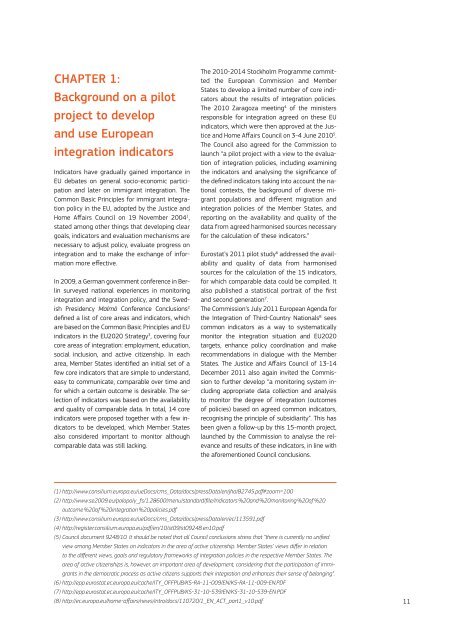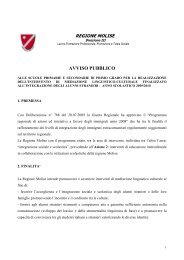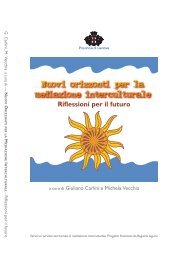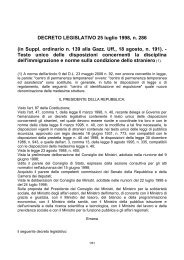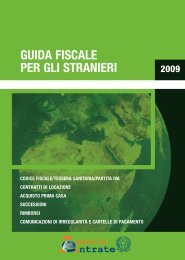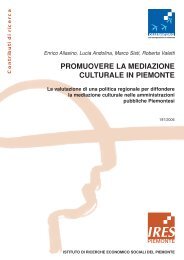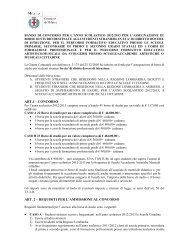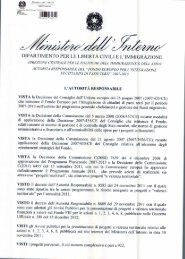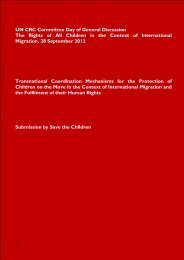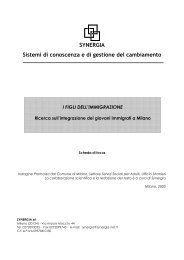Using EU Indicators of Immigrant Integration - European ...
Using EU Indicators of Immigrant Integration - European ...
Using EU Indicators of Immigrant Integration - European ...
- No tags were found...
You also want an ePaper? Increase the reach of your titles
YUMPU automatically turns print PDFs into web optimized ePapers that Google loves.
Chapter 1:Background on a pilotproject to developand use <strong>European</strong>integration indicators<strong>Indicators</strong> have gradually gained importance in<strong>EU</strong> debates on general socio-economic participationand later on immigrant integration. TheCommon Basic Principles for immigrant integrationpolicy in the <strong>EU</strong>, adopted by the Justice andHome Affairs Council on 19 November 2004 1 ,stated among other things that developing cleargoals, indicators and evaluation mechanisms arenecessary to adjust policy, evaluate progress onintegration and to make the exchange <strong>of</strong> informationmore effective.In 2009, a German government conference in Berlinsurveyed national experiences in monitoringintegration and integration policy, and the SwedishPresidency Malmö Conference Conclusions 2defined a list <strong>of</strong> core areas and indicators, whichare based on the Common Basic Principles and <strong>EU</strong>indicators in the <strong>EU</strong>2020 Strategy 3 , covering fourcore areas <strong>of</strong> integration: employment, education,social inclusion, and active citizenship. In eacharea, Member States identified an initial set <strong>of</strong> afew core indicators that are simple to understand,easy to communicate, comparable over time andfor which a certain outcome is desirable. The selection<strong>of</strong> indicators was based on the availabilityand quality <strong>of</strong> comparable data. In total, 14 coreindicators were proposed together with a few indicatorsto be developed, which Member Statesalso considered important to monitor althoughcomparable data was still lacking.The 2010-2014 Stockholm Programme committedthe <strong>European</strong> Commission and MemberStates to develop a limited number <strong>of</strong> core indicatorsabout the results <strong>of</strong> integration policies.The 2010 Zaragoza meeting 4 <strong>of</strong> the ministersresponsible for integration agreed on these <strong>EU</strong>indicators, which were then approved at the Justiceand Home Affairs Council on 3-4 June 2010 5 .The Council also agreed for the Commission tolaunch “a pilot project with a view to the evaluation<strong>of</strong> integration policies, including examiningthe indicators and analysing the significance <strong>of</strong>the defined indicators taking into account the nationalcontexts, the background <strong>of</strong> diverse migrantpopulations and different migration andintegration policies <strong>of</strong> the Member States, andreporting on the availability and quality <strong>of</strong> thedata from agreed harmonised sources necessaryfor the calculation <strong>of</strong> these indicators.”Eurostat’s 2011 pilot study 6 addressed the availabilityand quality <strong>of</strong> data from harmonisedsources for the calculation <strong>of</strong> the 15 indicators,for which comparable data could be compiled. Italso published a statistical portrait <strong>of</strong> the firstand second generation 7 .The Commission’s July 2011 <strong>European</strong> Agenda forthe <strong>Integration</strong> <strong>of</strong> Third-Country Nationals 8 seescommon indicators as a way to systematicallymonitor the integration situation and <strong>EU</strong>2020targets, enhance policy coordination and makerecommendations in dialogue with the MemberStates. The Justice and Affairs Council <strong>of</strong> 13-14December 2011 also again invited the Commissionto further develop “a monitoring system includingappropriate data collection and analysisto monitor the degree <strong>of</strong> integration (outcomes<strong>of</strong> policies) based on agreed common indicators,recognising the principle <strong>of</strong> subsidiarity”. This hasbeen given a follow-up by this 15-month project,launched by the Commission to analyse the relevanceand results <strong>of</strong> these indicators, in line withthe aforementioned Council conclusions.(1) http://www.consilium.europa.eu/ueDocs/cms_Data/docs/pressData/en/jha/82745.pdf#zoom=100(2) http://www.se2009.eu/polopoly_fs/1.28600!menu/standard/file/<strong>Indicators</strong> %20and %20monitoring%20<strong>of</strong> %20outcome %20<strong>of</strong>%20integration %20policies.pdf(3) http://www.consilium.europa.eu/ueDocs/cms_Data/docs/pressData/en/ec/113591.pdf(4) http://register.consilium.europa.eu/pdf/en/10/st09/st09248.en10.pdf(5) Council document 9248/10. It should be noted that all Council conclusions stress that “there is currently no unifiedview among Member States on indicators in the area <strong>of</strong> active citizenship. Member States’ views differ in relationto the different views, goals and regulatory frameworks <strong>of</strong> integration policies in the respective Member States. Thearea <strong>of</strong> active citizenships is, however, an important area <strong>of</strong> development, considering that the participation <strong>of</strong> immigrantsin the democratic process as active citizens supports their integration and enhances their sense <strong>of</strong> belonging”.(6) http://epp.eurostat.ec.europa.eu/cache/ITY_OFFPUB/KS-RA-11-009/EN/KS-RA-11-009-EN.PDF(7) http://epp.eurostat.ec.europa.eu/cache/ITY_OFFPUB/KS-31-10-539/EN/KS-31-10-539-EN.PDF(8) http://ec.europa.eu/home-affairs/news/intro/docs/110720/1_EN_ACT_part1_v10.pdf11


